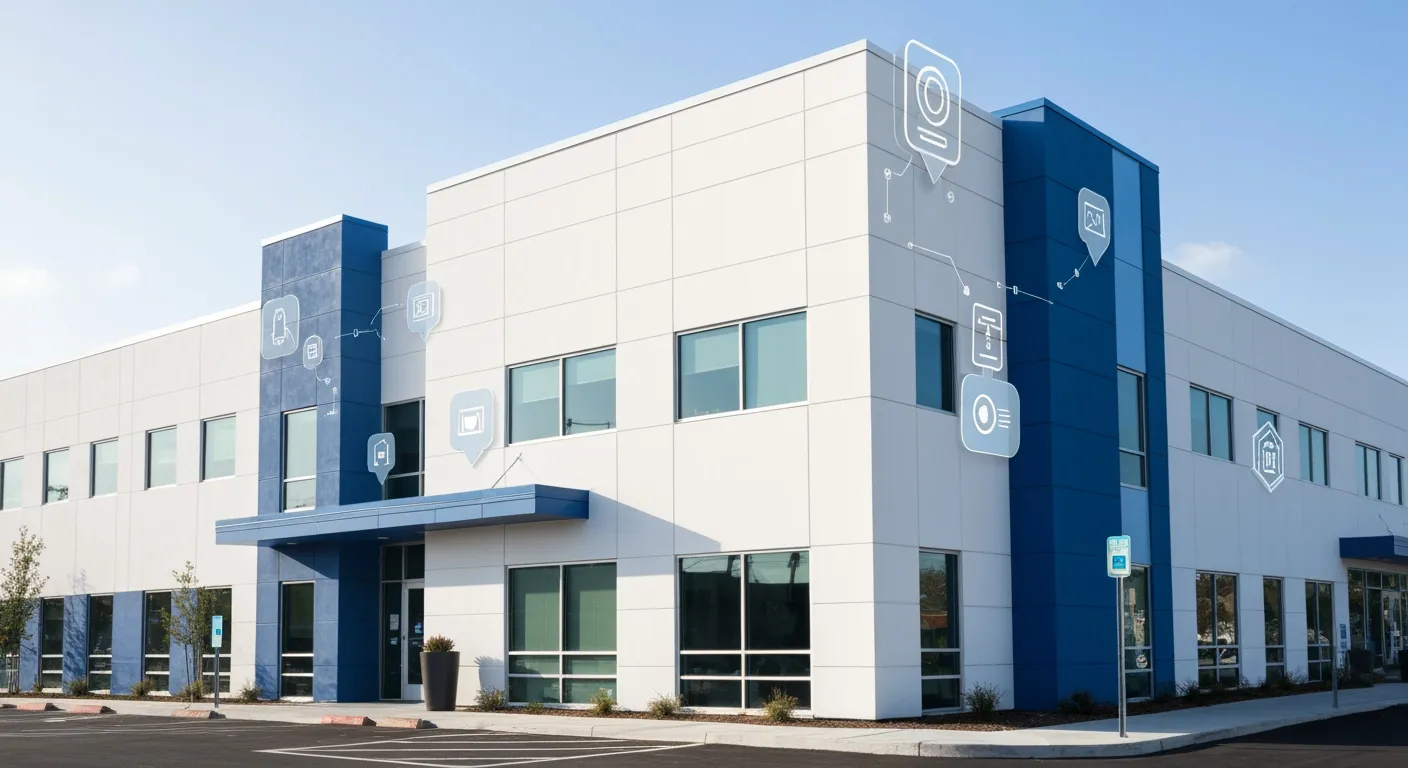Introduction: The Critical Role of Digital Marketing in Healthcare Patient Acquisition
The Growing Influence of Digital Marketing in Healthcare
In today's healthcare environment, digital marketing has emerged as an essential tool for patient acquisition and practice growth. With approximately 77% of patients conducting online research before booking an appointment, the digital presence of a healthcare provider significantly impacts patient decisions.
Patient Online Research Behavior
Nearly 60 to 80% of U.S. adults turn to the internet to find health-related information. This behavior highlights the necessity for healthcare organizations to maintain an easily accessible and informative online presence. Search engines drive three times more visitors to healthcare websites than other sources, with mobile users playing a substantial role, as over half of searches occur on mobile devices.
The Need for Targeted Digital Strategies
Effective patient acquisition requires more than just online visibility. Understanding the target audience through demographic and behavioral data enables the creation of personalized and targeted digital campaigns. These strategies leverage tools such as search engine optimization (SEO), social media marketing, and digital advertising to engage patients where they are most active and improve conversion rates.
By aligning digital marketing efforts with patient behaviors and preferences, healthcare providers can foster trust, streamline patient engagement, and ultimately increase patient acquisition in a competitive healthcare landscape.
Understanding Your Audience: The Foundation of Effective Patient Acquisition

How can healthcare providers better understand their target audience?
Healthcare providers enhance patient acquisition by conducting a thorough analysis of their target audience. This involves evaluating demographic factors such as age, income, and household size to identify distinct healthcare consumer segments using demographic modeling for healthcare techniques.
In addition, providers analyze digital behaviors to comprehend how patients seek health information online and engage with digital platforms. This insight allows for crafting targeted engagement strategies that meet patients where they are most active, incorporating digital patient acquisition strategies and healthcare marketing digital strategies.
Clinical propensity models serve as predictive tools by combining claims and consumer data to forecast health-related actions, such as likelihood of vaccination or participation in screenings. These models enable providers to focus resources on patients with higher probabilities of engagement through clinical propensity models in patient engagement.
Integrating social determinants of health (SDOH) is equally important. This approach considers external factors like socioeconomic status, education, and environment that influence patient health behavior and outcomes, enabling more personalized and effective outreach as part of social determinants of health integration.
By combining demographic analysis, digital behavior insights, predictive modeling, and SDOH integration, healthcare organizations create customized marketing strategies that resonate with their audiences and optimize patient acquisition efforts through media and channel models for healthcare marketing and predictive targeting for patient acquisition.
Building a Strong Online Presence: Essential Digital Foundations

What role does a strong online presence play in healthcare patient acquisition?
A strong online presence is vital for healthcare patient acquisition because the majority of patients begin their healthcare journey by researching providers online. According to multiple studies, over 77% of patients use online resources before booking appointments. This behavior underscores the necessity for healthcare practices to have a responsive and mobile-optimized website that offers a seamless user experience across devices. Mobile-friendly sites not only enhance patient engagement but also improve search engine rankings, especially given that more than half of health-related searches occur on mobile devices (Digital marketing in healthcare, Mobile optimization for healthcare websites).
Responsive and Mobile-Optimized Websites
Healthcare websites must load quickly, be easy to navigate, and adapt fluidly to different screen sizes to accommodate patients researching on smartphones or tablets. A website optimized for mobile devices reduces frustration and encourages visitors to take action—such as scheduling appointments or contacting the practice (Mobile compatibility in healthcare websites, Online appointment scheduling). High-quality, patient-focused content including educational articles, clear calls-to-action, and testimonials enhances credibility and drives conversion (Creating educational healthcare content, Patient testimonials for acquisition.
Local Business Listings
Maintaining accurate and comprehensive local business listings on platforms like Google Business Profile, Yelp, and Healthgrades is essential. These listings improve visibility within local search results and make it easier for prospective patients to find, contact, and engage with healthcare providers (Optimizing Google Business Profiles and local SEO for healthcare practices). Optimized profiles with updated contact information, hours, and photos contribute to higher search rankings and better patient trust (Importance of local business listings.
SEO Essentials
Search engine optimization (SEO) strategies including keyword usage, technical website health, backlink building, and regularly updated content ensure healthcare practices rank prominently in search results for relevant queries, such as “primary care near me” or “urgent care center.” Healthcare SEO also focuses heavily on local SEO for healthcare practices tactics, which are critical as 90% of patients perform local searches to find providers nearby (Healthcare SEO best practices).
Online Reputation and Review Management
Patient reviews are among the most influential factors in healthcare provider selection. Nearly 90% of patients read online reviews when evaluating providers. Proactively requesting reviews, monitoring feedback, and responding professionally to both positive and negative comments build patient trust and credibility (Reputation management tools, Managing online reputation in healthcare). Robust reputation management not only enhances patient acquisition but fosters long-term patient loyalty and referral growth (Patient retention strategies, Healthcare online reputation management.
By integrating these digital foundations—responsive websites, local listing optimization, SEO, and review management—healthcare organizations establish an authoritative online presence that effectively attracts and converts prospective patients in today’s digital-first environment (Digital patient acquisition strategies, Healthcare digital marketing strategies).
Leveraging Search Engine Optimization (SEO) and Paid Advertising to Drive Patient Traffic

How do SEO and paid ads contribute to attracting new patients?
Effective SEO strategies are foundational to attracting new patients by improving a healthcare provider’s visibility in search engine results. This involves thorough keyword optimization tailored to the medical services offered and the target patient demographics.
Creating high-quality, informative, and relevant content around these keywords serves to educate prospective patients and fulfills their search intent, driving organic traffic. Technical SEO ensures that websites load quickly, are mobile-friendly, and have efficient crawlability, all of which increase search rankings and enhance user experience.
Local SEO for healthcare practices plays a critical role by optimizing Google Business profiles and ensuring accurate local listings. This visibility in local search results is essential since many patients search for providers "near me" or within their community.
Paid advertising, particularly pay-per-click (PPC) campaigns, complements SEO by offering immediate, targeted visibility. PPC ads can appear atop search engine results pages or on social media platforms, targeting specific geographic areas and patient demographics to drive direct inquiries and appointment bookings.
Combining SEO and paid advertising strategies creates a powerful synergy. While SEO builds long-term organic presence and trust, paid ads provide quick bursts of traffic and message control, maximizing overall reach and increasing conversion rates. Healthcare providers employing both methods can significantly enhance patient acquisition efforts with measurable results.
Content and Video Marketing: Engaging and Educating Prospective Patients

Why are content and video marketing effective for patient acquisition?
Content marketing through educational blogs and videos serves as a powerful strategy to engage prospective patients by delivering valuable health information. This approach not only builds trust but also establishes the healthcare provider's expertise, which is critical in a competitive marketplace (healthcare marketing ideas, video marketing in healthcare, healthcare content marketing strategies).
Creating educational blogs and videos
Healthcare providers benefit from regularly producing blogs that address common health concerns, treatment options, and wellness tips. Educational videos complement these efforts by offering clear, accessible explanations and visually engaging patient education, which can reach diverse audiences including aging populations who actively seek treatment information online (creating educational healthcare content, Video marketing in healthcare, patient engagement through content marketing.
Video marketing impact on conversions
Integrating video content on landing pages has been shown to increase conversion rates by up to 80%. Videos effectively communicate messages with emotional resonance and clarity, helping patients better understand services and feel more comfortable engaging with the practice (video marketing for medical practices, patient testimonials video content, video and streaming ads.
Building trust with valuable content
Consistent delivery of relevant and informative content helps nurture patient trust. By answering frequently asked questions and providing guidance, healthcare marketers create a positive experience that supports decision-making and loyalty (building patient trust online, patient engagement tools, healthcare consumer empowerment).
Patient storytelling and testimonials
Patient testimonials and real-life stories are powerful tools to boost credibility and patient connection. Sharing these narratives on digital platforms humanizes the healthcare experience, encouraging prospective patients to schedule appointments and fostering long-term relationships (patient testimonials in healthcare, patient testimonials video content, Importance of patient reviews).
Harnessing Social Media and Email Marketing for Patient Engagement and Growth

How do social media and email marketing support patient acquisition?
Social media significantly impacts patient treatment decisions, with about 57% of consumers influenced by this channel. Healthcare practices can leverage both organic posts and targeted paid campaigns to engage patients effectively. These efforts build trust and foster patient relationships while strictly following HIPAA guidelines to safeguard privacy.
Email marketing continues to be a powerful tool for patient acquisition and retention. Personalized campaigns tailored to patient data increase engagement and conversion rates. Incorporating educational content and clear calls-to-action helps patients stay informed and motivated to seek care.
Optimizing email campaigns for mobile devices is essential, given widespread mobile usage. Utilizing professional templates and segmenting email lists ensure that messages are relevant and accessible, improving the overall patient experience and boosting response rates.
Together, social media and email marketing form an integrated strategy that supports patient growth by delivering meaningful, compliant, and targeted communication across preferred digital channels.
Implementing Advanced Data-Driven and Predictive Marketing Techniques

What role does data-driven marketing play in healthcare patient acquisition?
Data-driven marketing is essential for effective patient acquisition in healthcare. By leveraging analytics and key performance indicators (KPIs), healthcare providers gain deep insights into consumer behavior and demand patterns. This enables precision in audience segmentation and targeting, allowing campaigns to reach high-value patient populations more efficiently through predictive targeting for patient acquisition.
Using analytics and KPIs
KPIs such as appointment bookings, phone call volumes, conversion rates, and patient satisfaction scores are tracked continuously to measure campaign success. Healthcare marketing analytics and data tracking platforms help optimize marketing spend by highlighting the most effective channels and messages, ensuring resources generate the highest return.
Patient segmentation and targeting models
Advanced segmentation uses demographic data (age, income, household size), clinical propensity models in patient engagement predicting health behaviors (e.g., vaccination rates), and social determinants of health integration to identify patient segments with the greatest acquisition potential. Tailored marketing messages and interventions are designed based on these insights to enhance engagement and improve healthcare consumer segment identification.
Media Mix Modeling and population intelligence
Media Mix Modeling for healthcare marketing evaluates the impact of marketing channels and allocates budgets accordingly, increasing efficiency. Definitive Healthcare Population Intelligence platform combines claims data with consumer information to predict patient needs and behavior, supporting targeted advertising campaigns through demand-side platforms for patient targeting.
Balancing acquisition with retention
While acquiring new patients is critical, balancing it with retention strategies ensures sustainable practice growth. Maintaining strong patient engagement through personalized healthcare communication and automated follow-ups reduces churn and increases lifetime value, complementing acquisition efforts.
Employing these sophisticated, data-driven marketing methods empowers healthcare organizations to optimize their digital patient acquisition strategies, improve patient experiences, and achieve measurable growth.
Streamlining Patient Experience Through Digital Tools and Automation

How do digital tools improve patient acquisition and experience?
Digital transformation in healthcare marketing not only attracts new patients but also significantly enhances their overall experience. Online self-scheduling empowers patients to book appointments at their convenience, outside traditional office hours, which reduces appointment cancellations and no-show rates. This accessibility aligns well with patient preferences, particularly among Gen X and millennial demographics (Local SEO for Healthcare Practices, Online self-scheduling tools.
Digital patient intake forms streamline the onboarding process by reducing paperwork and minimizing errors through direct data entry. These forms often integrate smoothly with electronic health records (EHR) and practice management systems, facilitating accurate and up-to-date patient information flow without manual duplication (Digital patient intake forms, Practice management integration.
Integration with EHR systems enables real-time syncing of patient data, improving coordination between front-office operations and clinical care. Practice management software further supports scheduling, billing, and patient communication, creating a seamless administrative workflow (Practice management software for patient acquisition, Self-scheduling options for patients.
Automated communication tools, such as appointment reminders via email or SMS and post-visit surveys, improve patient engagement and retention. These automated touchpoints reduce missed appointments and gather valuable feedback to enhance service quality (Automated patient communications, Patient retention strategies). Collectively, these digital solutions contribute to higher patient satisfaction, increased retention, and measurable gains in patient acquisition rates, ultimately supporting sustainable practice growth (Healthcare digital marketing strategies, Winning strategies for digital patient acquisition).
Reputation Management and Community Engagement as Pillars of Patient Acquisition

Why is reputation management and community engagement important for patient acquisition?
Online reputation plays a critical role in healthcare marketing as 90% of patients read reviews before selecting providers. Timely and sincere requests for online reviews encourage patients to share their experiences, helping practices build a positive digital presence.
Responding professionally to both positive and negative reviews demonstrates commitment to patient care, fostering trust and encouraging prospective patients to choose the practice. This supports reputation management in healthcare, which is key for patient acquisition strategies.
Community partnerships with local businesses such as gyms or wellness centers create referral pipelines and enhance the practice’s credibility within the local market, aligning with referral partnerships in healthcare.
Active community engagement through sponsorships, health fairs, educational workshops, and local events establishes the practice as a trusted healthcare resource, which is crucial for building patient relationships and improving healthcare marketing effectiveness.
These efforts build lasting relationships, increase brand awareness, and directly support patient acquisition by attracting patients who prioritize trust and community connection in their healthcare decisions, as emphasized in patient acquisition strategies and digital patient acquisition strategies.
Ensuring Compliance and Privacy in Healthcare Digital Marketing

How do healthcare providers maintain compliance and privacy in digital marketing?
Healthcare digital marketing must uphold stringent compliance with regulations such as HIPAA compliance in marketing and GDPR compliance in healthcare marketing to secure patient information. Providers use HIPAA-compliant communication platforms and secure messaging to ensure data privacy during patient interactions.
Privacy-first marketing techniques are gaining prominence; these include anonymized data collection and contextual advertising strategies that minimize personal data exposure while maintaining campaign effectiveness.
Secure communication channels are essential, offering encrypted messaging systems and tools designed to safeguard patient data throughout marketing efforts.
Balancing robust data collection with patient privacy involves transparent consent protocols and employing compliant analytics tools in healthcare that respect privacy laws. This dual approach enhances patient trust, mitigates legal risks, and fosters ethical marketing.
Adherence to these principles is critical for healthcare organizations aiming to maintain credibility while leveraging digital marketing for patient relationships to attract and retain patients effectively.
Conclusion: Integrating Digital Marketing Strategies for Sustained Patient Acquisition Success
Importance of a Comprehensive Strategy
A successful patient acquisition approach must integrate multiple digital marketing tactics—including SEO, social media, targeted advertising, and reputation management—to effectively engage varying patient demographics and modern healthcare consumers.
Continuous Performance Measurement and Optimization
Ongoing monitoring of marketing KPIs such as appointment bookings and online engagement, coupled with data analytics and A/B testing, allows healthcare organizations to refine campaigns, maximize ROI, and adapt to shifting patient behaviors while ensuring regulatory compliance.
Building Lasting Patient Relationships
Beyond acquisition, retaining patients through personalized communication, streamlined digital experiences, and educational content fosters trust and loyalty, creating a sustainable patient base that supports long-term growth.
Future Trends in Healthcare Marketing
Emerging trends emphasize privacy-first marketing, AI-driven personalization, omnichannel communication, and enhanced video content, all of which healthcare marketers must leverage to stay competitive and responsive to evolving patient expectations.
Introduction: The Critical Role of Digital Marketing in Healthcare Patient Acquisition
The Growing Influence of Digital Marketing in Healthcare
In today's healthcare environment, digital marketing has emerged as an essential tool for patient acquisition and practice growth. With approximately 77% of patients conducting online research before booking an appointment, the digital presence of a healthcare provider significantly impacts patient decisions.
Patient Online Research Behavior
Nearly 60 to 80% of U.S. adults turn to the internet to find health-related information. This behavior highlights the necessity for healthcare organizations to maintain an easily accessible and informative online presence. Search engines drive three times more visitors to healthcare websites than other sources, with mobile users playing a substantial role, as over half of searches occur on mobile devices.
The Need for Targeted Digital Strategies
Effective patient acquisition requires more than just online visibility. Understanding the target audience through demographic and behavioral data enables the creation of personalized and targeted digital campaigns. These strategies leverage tools such as search engine optimization (SEO), social media marketing, and digital advertising to engage patients where they are most active and improve conversion rates.
By aligning digital marketing efforts with patient behaviors and preferences, healthcare providers can foster trust, streamline patient engagement, and ultimately increase patient acquisition in a competitive healthcare landscape.
Understanding Your Audience: The Foundation of Effective Patient Acquisition

How can healthcare providers better understand their target audience?
Healthcare providers enhance patient acquisition by conducting a thorough analysis of their target audience. This involves evaluating demographic factors such as age, income, and household size to identify distinct healthcare consumer segments using demographic modeling for healthcare techniques.
In addition, providers analyze digital behaviors to comprehend how patients seek health information online and engage with digital platforms. This insight allows for crafting targeted engagement strategies that meet patients where they are most active, incorporating digital patient acquisition strategies and healthcare marketing digital strategies.
Clinical propensity models serve as predictive tools by combining claims and consumer data to forecast health-related actions, such as likelihood of vaccination or participation in screenings. These models enable providers to focus resources on patients with higher probabilities of engagement through clinical propensity models in patient engagement.
Integrating social determinants of health (SDOH) is equally important. This approach considers external factors like socioeconomic status, education, and environment that influence patient health behavior and outcomes, enabling more personalized and effective outreach as part of social determinants of health integration.
By combining demographic analysis, digital behavior insights, predictive modeling, and SDOH integration, healthcare organizations create customized marketing strategies that resonate with their audiences and optimize patient acquisition efforts through media and channel models for healthcare marketing and predictive targeting for patient acquisition.
Building a Strong Online Presence: Essential Digital Foundations

What role does a strong online presence play in healthcare patient acquisition?
A strong online presence is vital for healthcare patient acquisition because the majority of patients begin their healthcare journey by researching providers online. According to multiple studies, over 77% of patients use online resources before booking appointments. This behavior underscores the necessity for healthcare practices to have a responsive and mobile-optimized website that offers a seamless user experience across devices. Mobile-friendly sites not only enhance patient engagement but also improve search engine rankings, especially given that more than half of health-related searches occur on mobile devices (Digital marketing in healthcare, Mobile optimization for healthcare websites).
Responsive and Mobile-Optimized Websites
Healthcare websites must load quickly, be easy to navigate, and adapt fluidly to different screen sizes to accommodate patients researching on smartphones or tablets. A website optimized for mobile devices reduces frustration and encourages visitors to take action—such as scheduling appointments or contacting the practice (Mobile compatibility in healthcare websites, Online appointment scheduling). High-quality, patient-focused content including educational articles, clear calls-to-action, and testimonials enhances credibility and drives conversion (Creating educational healthcare content, Patient testimonials for acquisition.
Local Business Listings
Maintaining accurate and comprehensive local business listings on platforms like Google Business Profile, Yelp, and Healthgrades is essential. These listings improve visibility within local search results and make it easier for prospective patients to find, contact, and engage with healthcare providers (Optimizing Google Business Profiles and local SEO for healthcare practices). Optimized profiles with updated contact information, hours, and photos contribute to higher search rankings and better patient trust (Importance of local business listings.
SEO Essentials
Search engine optimization (SEO) strategies including keyword usage, technical website health, backlink building, and regularly updated content ensure healthcare practices rank prominently in search results for relevant queries, such as “primary care near me” or “urgent care center.” Healthcare SEO also focuses heavily on local SEO for healthcare practices tactics, which are critical as 90% of patients perform local searches to find providers nearby (Healthcare SEO best practices).
Online Reputation and Review Management
Patient reviews are among the most influential factors in healthcare provider selection. Nearly 90% of patients read online reviews when evaluating providers. Proactively requesting reviews, monitoring feedback, and responding professionally to both positive and negative comments build patient trust and credibility (Reputation management tools, Managing online reputation in healthcare). Robust reputation management not only enhances patient acquisition but fosters long-term patient loyalty and referral growth (Patient retention strategies, Healthcare online reputation management.
By integrating these digital foundations—responsive websites, local listing optimization, SEO, and review management—healthcare organizations establish an authoritative online presence that effectively attracts and converts prospective patients in today’s digital-first environment (Digital patient acquisition strategies, Healthcare digital marketing strategies).
Leveraging Search Engine Optimization (SEO) and Paid Advertising to Drive Patient Traffic

How do SEO and paid ads contribute to attracting new patients?
Effective SEO strategies are foundational to attracting new patients by improving a healthcare provider’s visibility in search engine results. This involves thorough keyword optimization tailored to the medical services offered and the target patient demographics.
Creating high-quality, informative, and relevant content around these keywords serves to educate prospective patients and fulfills their search intent, driving organic traffic. Technical SEO ensures that websites load quickly, are mobile-friendly, and have efficient crawlability, all of which increase search rankings and enhance user experience.
Local SEO for healthcare practices plays a critical role by optimizing Google Business profiles and ensuring accurate local listings. This visibility in local search results is essential since many patients search for providers "near me" or within their community.
Paid advertising, particularly pay-per-click (PPC) campaigns, complements SEO by offering immediate, targeted visibility. PPC ads can appear atop search engine results pages or on social media platforms, targeting specific geographic areas and patient demographics to drive direct inquiries and appointment bookings.
Combining SEO and paid advertising strategies creates a powerful synergy. While SEO builds long-term organic presence and trust, paid ads provide quick bursts of traffic and message control, maximizing overall reach and increasing conversion rates. Healthcare providers employing both methods can significantly enhance patient acquisition efforts with measurable results.
Content and Video Marketing: Engaging and Educating Prospective Patients

Why are content and video marketing effective for patient acquisition?
Content marketing through educational blogs and videos serves as a powerful strategy to engage prospective patients by delivering valuable health information. This approach not only builds trust but also establishes the healthcare provider's expertise, which is critical in a competitive marketplace (healthcare marketing ideas, video marketing in healthcare, healthcare content marketing strategies).
Creating educational blogs and videos
Healthcare providers benefit from regularly producing blogs that address common health concerns, treatment options, and wellness tips. Educational videos complement these efforts by offering clear, accessible explanations and visually engaging patient education, which can reach diverse audiences including aging populations who actively seek treatment information online (creating educational healthcare content, Video marketing in healthcare, patient engagement through content marketing.
Video marketing impact on conversions
Integrating video content on landing pages has been shown to increase conversion rates by up to 80%. Videos effectively communicate messages with emotional resonance and clarity, helping patients better understand services and feel more comfortable engaging with the practice (video marketing for medical practices, patient testimonials video content, video and streaming ads.
Building trust with valuable content
Consistent delivery of relevant and informative content helps nurture patient trust. By answering frequently asked questions and providing guidance, healthcare marketers create a positive experience that supports decision-making and loyalty (building patient trust online, patient engagement tools, healthcare consumer empowerment).
Patient storytelling and testimonials
Patient testimonials and real-life stories are powerful tools to boost credibility and patient connection. Sharing these narratives on digital platforms humanizes the healthcare experience, encouraging prospective patients to schedule appointments and fostering long-term relationships (patient testimonials in healthcare, patient testimonials video content, Importance of patient reviews).
Harnessing Social Media and Email Marketing for Patient Engagement and Growth

How do social media and email marketing support patient acquisition?
Social media significantly impacts patient treatment decisions, with about 57% of consumers influenced by this channel. Healthcare practices can leverage both organic posts and targeted paid campaigns to engage patients effectively. These efforts build trust and foster patient relationships while strictly following HIPAA guidelines to safeguard privacy.
Email marketing continues to be a powerful tool for patient acquisition and retention. Personalized campaigns tailored to patient data increase engagement and conversion rates. Incorporating educational content and clear calls-to-action helps patients stay informed and motivated to seek care.
Optimizing email campaigns for mobile devices is essential, given widespread mobile usage. Utilizing professional templates and segmenting email lists ensure that messages are relevant and accessible, improving the overall patient experience and boosting response rates.
Together, social media and email marketing form an integrated strategy that supports patient growth by delivering meaningful, compliant, and targeted communication across preferred digital channels.
Implementing Advanced Data-Driven and Predictive Marketing Techniques

What role does data-driven marketing play in healthcare patient acquisition?
Data-driven marketing is essential for effective patient acquisition in healthcare. By leveraging analytics and key performance indicators (KPIs), healthcare providers gain deep insights into consumer behavior and demand patterns. This enables precision in audience segmentation and targeting, allowing campaigns to reach high-value patient populations more efficiently through predictive targeting for patient acquisition.
Using analytics and KPIs
KPIs such as appointment bookings, phone call volumes, conversion rates, and patient satisfaction scores are tracked continuously to measure campaign success. Healthcare marketing analytics and data tracking platforms help optimize marketing spend by highlighting the most effective channels and messages, ensuring resources generate the highest return.
Patient segmentation and targeting models
Advanced segmentation uses demographic data (age, income, household size), clinical propensity models in patient engagement predicting health behaviors (e.g., vaccination rates), and social determinants of health integration to identify patient segments with the greatest acquisition potential. Tailored marketing messages and interventions are designed based on these insights to enhance engagement and improve healthcare consumer segment identification.
Media Mix Modeling and population intelligence
Media Mix Modeling for healthcare marketing evaluates the impact of marketing channels and allocates budgets accordingly, increasing efficiency. Definitive Healthcare Population Intelligence platform combines claims data with consumer information to predict patient needs and behavior, supporting targeted advertising campaigns through demand-side platforms for patient targeting.
Balancing acquisition with retention
While acquiring new patients is critical, balancing it with retention strategies ensures sustainable practice growth. Maintaining strong patient engagement through personalized healthcare communication and automated follow-ups reduces churn and increases lifetime value, complementing acquisition efforts.
Employing these sophisticated, data-driven marketing methods empowers healthcare organizations to optimize their digital patient acquisition strategies, improve patient experiences, and achieve measurable growth.
Streamlining Patient Experience Through Digital Tools and Automation

How do digital tools improve patient acquisition and experience?
Digital transformation in healthcare marketing not only attracts new patients but also significantly enhances their overall experience. Online self-scheduling empowers patients to book appointments at their convenience, outside traditional office hours, which reduces appointment cancellations and no-show rates. This accessibility aligns well with patient preferences, particularly among Gen X and millennial demographics (Local SEO for Healthcare Practices, Online self-scheduling tools.
Digital patient intake forms streamline the onboarding process by reducing paperwork and minimizing errors through direct data entry. These forms often integrate smoothly with electronic health records (EHR) and practice management systems, facilitating accurate and up-to-date patient information flow without manual duplication (Digital patient intake forms, Practice management integration.
Integration with EHR systems enables real-time syncing of patient data, improving coordination between front-office operations and clinical care. Practice management software further supports scheduling, billing, and patient communication, creating a seamless administrative workflow (Practice management software for patient acquisition, Self-scheduling options for patients.
Automated communication tools, such as appointment reminders via email or SMS and post-visit surveys, improve patient engagement and retention. These automated touchpoints reduce missed appointments and gather valuable feedback to enhance service quality (Automated patient communications, Patient retention strategies). Collectively, these digital solutions contribute to higher patient satisfaction, increased retention, and measurable gains in patient acquisition rates, ultimately supporting sustainable practice growth (Healthcare digital marketing strategies, Winning strategies for digital patient acquisition).
Reputation Management and Community Engagement as Pillars of Patient Acquisition

Why is reputation management and community engagement important for patient acquisition?
Online reputation plays a critical role in healthcare marketing as 90% of patients read reviews before selecting providers. Timely and sincere requests for online reviews encourage patients to share their experiences, helping practices build a positive digital presence.
Responding professionally to both positive and negative reviews demonstrates commitment to patient care, fostering trust and encouraging prospective patients to choose the practice. This supports reputation management in healthcare, which is key for patient acquisition strategies.
Community partnerships with local businesses such as gyms or wellness centers create referral pipelines and enhance the practice’s credibility within the local market, aligning with referral partnerships in healthcare.
Active community engagement through sponsorships, health fairs, educational workshops, and local events establishes the practice as a trusted healthcare resource, which is crucial for building patient relationships and improving healthcare marketing effectiveness.
These efforts build lasting relationships, increase brand awareness, and directly support patient acquisition by attracting patients who prioritize trust and community connection in their healthcare decisions, as emphasized in patient acquisition strategies and digital patient acquisition strategies.
Ensuring Compliance and Privacy in Healthcare Digital Marketing

How do healthcare providers maintain compliance and privacy in digital marketing?
Healthcare digital marketing must uphold stringent compliance with regulations such as HIPAA compliance in marketing and GDPR compliance in healthcare marketing to secure patient information. Providers use HIPAA-compliant communication platforms and secure messaging to ensure data privacy during patient interactions.
Privacy-first marketing techniques are gaining prominence; these include anonymized data collection and contextual advertising strategies that minimize personal data exposure while maintaining campaign effectiveness.
Secure communication channels are essential, offering encrypted messaging systems and tools designed to safeguard patient data throughout marketing efforts.
Balancing robust data collection with patient privacy involves transparent consent protocols and employing compliant analytics tools in healthcare that respect privacy laws. This dual approach enhances patient trust, mitigates legal risks, and fosters ethical marketing.
Adherence to these principles is critical for healthcare organizations aiming to maintain credibility while leveraging digital marketing for patient relationships to attract and retain patients effectively.
Conclusion: Integrating Digital Marketing Strategies for Sustained Patient Acquisition Success
Importance of a Comprehensive Strategy
A successful patient acquisition approach must integrate multiple digital marketing tactics—including SEO, social media, targeted advertising, and reputation management—to effectively engage varying patient demographics and modern healthcare consumers.
Continuous Performance Measurement and Optimization
Ongoing monitoring of marketing KPIs such as appointment bookings and online engagement, coupled with data analytics and A/B testing, allows healthcare organizations to refine campaigns, maximize ROI, and adapt to shifting patient behaviors while ensuring regulatory compliance.
Building Lasting Patient Relationships
Beyond acquisition, retaining patients through personalized communication, streamlined digital experiences, and educational content fosters trust and loyalty, creating a sustainable patient base that supports long-term growth.
Future Trends in Healthcare Marketing
Emerging trends emphasize privacy-first marketing, AI-driven personalization, omnichannel communication, and enhanced video content, all of which healthcare marketers must leverage to stay competitive and responsive to evolving patient expectations.






